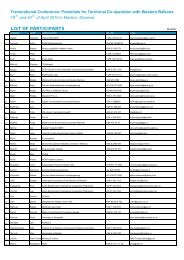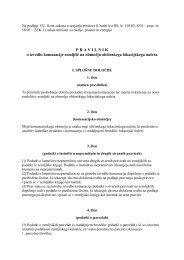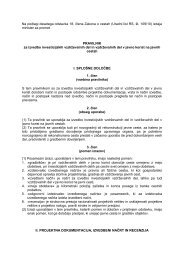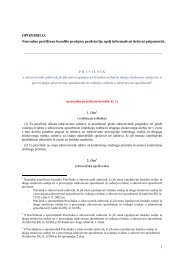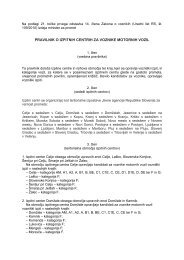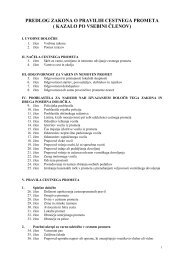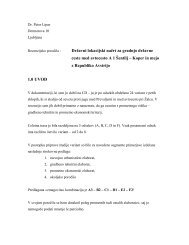evropska konvencija o krajini - Ministrstvo za infrastrukturo in prostor
evropska konvencija o krajini - Ministrstvo za infrastrukturo in prostor
evropska konvencija o krajini - Ministrstvo za infrastrukturo in prostor
You also want an ePaper? Increase the reach of your titles
YUMPU automatically turns print PDFs into web optimized ePapers that Google loves.
52Delavnica 1 / Workshop 1koncepti težijo k posploševanju <strong>in</strong> poenostavljanjukompleksne stvarnosti, tudi strokovneklasifikacije <strong>in</strong> tipologije težijo k poenostavitv<strong>in</strong>ašega odnosa do kraj<strong>in</strong>. Ta preprost <strong>in</strong>enostaven pristop pa je v kraj<strong>in</strong>skem planiranjulahko nevaren – adm<strong>in</strong>istrativno je zeloprivlačen, saj je na kraj<strong>in</strong>ske tipe možno zlahkoto nave<strong>za</strong>ti normativen nač<strong>in</strong> <strong>prostor</strong>skegarazvoja <strong>in</strong> varstva. Vendar je taka pregledna <strong>in</strong>preprosta delitev v <strong>prostor</strong>skem načrtovanjudejansko kontraproduktivna. Operativno je sicerprivlačna, saj je nanjo kot na videznespremenljivo zlahka moč nave<strong>za</strong>ti normativn<strong>in</strong>ač<strong>in</strong> <strong>prostor</strong>skega razvoja oziroma varstva, ki jeenostavnejši, zlasti <strong>za</strong> državno adm<strong>in</strong>istracijo, nepripelje pa do optimalnih oziroma optimiziranihpredlogov <strong>prostor</strong>skega razvoja <strong>in</strong> varstva. Dopredlogov, ki bi bili izbrani izmed dovolj alternativ<strong>in</strong> bi ponudili možnost <strong>prostor</strong>skega razvoja ponačelu najmanjše škode 15 .Če bomo že kdajkoli iskali skupni imenovalecevropskih kulturnih kraj<strong>in</strong>, je to ob dejanski<strong>prostor</strong>ski <strong>in</strong> zgodov<strong>in</strong>ski kulturni raznolikostiznotraj <strong>in</strong> zunaj meja sedanje evropskeskupnosti lahko samo njihova raznolikost. Taraznolikost <strong>za</strong>hteva optimi<strong>za</strong>cijske postopke<strong>prostor</strong>skega načrtovanja <strong>in</strong> prav v njih samih je<strong>za</strong>jeto tudi varstvo naravnih <strong>in</strong> kulturnih kraj<strong>in</strong>.the treatment of landscapes should be balancedwith the awareness that landscapes are culturalconstructs even more then they are natural phenomena.But one does not exclude the other.Cultural constructions of landscapes emergefrom a very ancient relationship of humans tonature. Even though, at least from Enlightenmentonwards 13 , the history of the landscape <strong>in</strong>the West seems like an unscrupulous exploitationof the earth, »where measurement, notmemory, is the absolute arbiter of value«, theclear-cut opposition between European cultureand nature is questionable, argues Schama, reveal<strong>in</strong>gthe power of the ancient l<strong>in</strong>ks betweenthe two 14 . Landscape heritage at this part of theworld evolved, paraphras<strong>in</strong>g Thoreau, on thefoundations of the Western landscape imag<strong>in</strong>ationwhich envisioned its own fertile world fromwoods, waters and rocks. Our nature myths, <strong>in</strong>fact, have never gone away; they lie just below thesurface of the seem<strong>in</strong>g reality of our landscapes.As much as mythological conceptions tend togeneralize and simplify complex realities, professionalclassifications and typologies tend tostraighten out our relationship to the landscapes.But this simple and easy approach isperilous <strong>in</strong> landscape plann<strong>in</strong>g – it is very attractivefor adm<strong>in</strong>istrative actions, because the normativeway of spatial development and protectionis easily attached to types and classes. Asa fixed description it is simple, especially for thestate adm<strong>in</strong>istration, but it can not lead to theoptimal and optimized suggestions for spatialprotection and development. It erases the possibilityfor a most feasible suggestion to be selectedamong many alternatives and neglect theoption of spatial development on the pr<strong>in</strong>ciple ofm<strong>in</strong>imal damage 15 .If sometime the common denom<strong>in</strong>ator of Europeancultural landscape should become an issue,along the objective spatial and cultural diversitywith<strong>in</strong> and beyond the borders of thepresent European Union, this could only be theirdiversity. This diversity deserves optimi<strong>za</strong>tionprocedures of landscape plann<strong>in</strong>g, which arealso the only way to secure protection of naturaland cultural landscapes.15V obratu od antropocentrične k biocentrični etiki Paul W. Taylor, v Respect for Nature: a Theory of Environmental Ethics (Pr<strong>in</strong>ceton 1986) razvije etično stališče,po katerem naj bi prioritetni pr<strong>in</strong>cipi, ki razrešujejo konflikte med ljudmi <strong>in</strong> drugimi vrstami, kadar pride do tekmovanja <strong>za</strong> omejene vire ali <strong>za</strong> življenjski<strong>prostor</strong>, sledili načelu najmanjše škode. To načelo je zlahka moč aplicirati v razreševanje konfliktnih <strong>in</strong>teresov po razvoju <strong>in</strong> varstvu v kraj<strong>in</strong>skem planiranju.Concerned with the moral relations that hold between humans and the natural world, Paul W. Taylor, Respect for Nature: a Theory of Environmental Ethics(Pr<strong>in</strong>ceton 1986) developed the ethical stand, by which priority pr<strong>in</strong>ciples for resolv<strong>in</strong>g conflicts between humans and other species when there is competitionfor limited resources and habitats should follow the pr<strong>in</strong>ciple of m<strong>in</strong>imal damage. This pr<strong>in</strong>ciple could easily be applied to the conflict<strong>in</strong>g <strong>in</strong>terests ofdevelopment and protection encountered <strong>in</strong> landscape plann<strong>in</strong>g.



